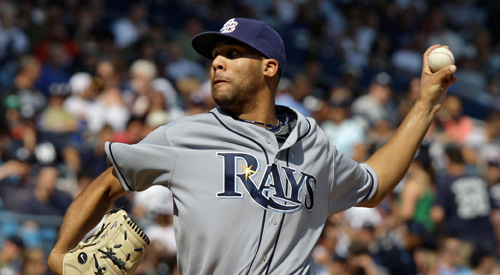
Breaking down the REAL Tampa Bay Rays
In 2007, they were the Tampa Bay Devil Rays. They finished 66-96, five games better than the previous season, the worst team in baseball.
In 2008, they were the Tampa Bay Rays. They finished 97-65 with the third-best record in baseball, and they lost the World Series in five games to the Philadelphia Phillies.
Among the many reactions to the surprising new power in their AL East, the most three most prevalent opinions:
– The Rays are a one-year wonder, that’s all.
– Of course they’re good. They drafted in the top five eight times between 2001 and 2008, including three first-overall picks. They should be good.
– They don’t matter in the long run since they’re only going to lose their best players to free agency anyway.
Well…
The Rays were not a fluke.
They finished in third place in 2009; won the AL East again in 2010, topping the Yankees by a game; made a memorable charge to steal the wild card slot from the Red Sox on the last day of the 2011 season; earned themselves the attention of a book by Jonah Keri; and are currently regarded as one of the powers in the American League.
[php snippet=1]
The early first rounders drafted by the Rays have been… eh.
Third-overall pick Dewon Brazelton (2001) bombed. Second-overall pick B.J. Upton (2002) has tools and is a fine defensive outfielder but no perennial All-Star. First-overall pick Delmon Young (2003) presented character, coachability, and defensive issues and was summarily shipped off to Minnesota. Fourth-overall pick Jeff Niemann (2004), like Upton, has never lived up to his advertised talent. Eighth-overall pick Wade Townsend (2005) never made it to Triple-A. First-overall pick Tim Beckham (2008) appears as though he’ll never be an impact Major Leaguer.
In an eight-year span of selecting top amateur talent, Tampa Bay found two stars — Evan Longoria and David Price. That’s all.
Contrary to popular opinion (and this article), the Rays have not been hurt by free agency.
Despite their greater resources, large-market teams have been unable to sabotage the Rays. Signing Carl Crawford has been disastrous for the Boston Red Sox. Carlos Pena did not work out for the Chicago Cubs. Bullpen stalwarts Joaquin Benoit, Grant Balfour and Rafael Soriano left for less artificial pastures, but their replacements have ably filled their roles.
I wonder how many folks in 2008 believed that not only were the Rays here to stay, but their success wasn’t even predicated on keeping their best players in place.
The men who were once considered the faces of the franchise – Jorge Cantu, Scott Kazmir and Crawford – are all gone now. Akinori Iwamura’s productive role turned fleeting. The catching position, which looked certain to belong to Dioner Navarro, has become a revolving door. Pat Burrell flopped as a free agent, as did Manny Ramirez. Matt Garza and Jason Bartlett, acquired for Young and viewed as symbols of the brilliance of the Rays’ front office, were dealt away themselves. Evan Longoria, the star third baseman and new face of the franchise, suffered early-season injuries in 2011 and 2012 that cost him valuable time in the lineup.
The homegrown talent, much ballyhooed, has disappointed. Wade Davis and Jake McGee have failed to live up to their headlines and may go the way of Andy Sonnanstine soon. Reid Brignac has not hit. Tim Beckham has busted. Desmond Jennings, like Upton and Niemann before him, looks to be a solid sort rather than a star. We’ll give Matt Moore a pass for now, though he’s disappointed thus far. (Don’t even ask about his fellow pitching prospects along the Rays’ organizational ladder, the majority of who are off to far from impressive starts.)
Thus it is that a lineup that once was composed of prospects and dynamic talents now features a motley crew of 27-year-olds and 30-somethings, driven onward by inexpensive signees, waiver pickups, platoon players and super utility men, all arranged in unorthodox sequences by Joe Maddon, manager and renaissance man.
What are the reactions to the Rays now?
Scorn, annoyance, jealousy and outright hatred are all delivered from opposition fans in the AL East. (AL East fans particularly hate Maddon’s defensive shifts.)
There’s also the insulting remark about the lack of fans at Tropicana Field. (Note that the White Sox, Indians, Athletics and Mariners are each drawing a smaller average attendance per game than the Rays.)
The biggest reaction? Disinterest.
So the Rays are winning again.
So what?
They’re a team with a $63.2 million payroll, winning games in the most difficult division in baseball. A team that wins with others’ cast-offs rather than the “high-priced mercenary superstars” that are so despised by older fans.
A team that wins with an interesting, introspective, creative, quotable manager at its helm, a remarkable pitching staff, a resilient roster, and an ever-changing collection of heroes without egos.
The New York Yankees represent the Classic American Dream of inherited success and showered wealth, with all of the arrogance and unctuousness that comes with it. The Boston Red Sox represent the Classic American Narrative of failure, success and heartbreak.
(The Toronto Blue Jays, in case you were wondering, represent something classically Canadian, with past memories of triumph, present optimism and great jerseys all making way for hockey conversation before long.)
But the Rays represent the true American Experience: the struggles, the doubts, the doubters, the brief flicker of hope followed by disappointment, the increased obstacles, and, ultimately, a measure of personal success that is only appreciated and admired by a select few. They cannot help where they live or what resources they have, but they can put their utmost into producing the finest results they can manage.
Baseball is better for it.
[php snippet=1]

